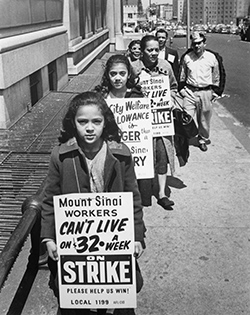Remembering 1199’s History: 1959 Organizing of Involuntary Philanthropists
January 28, 2021

Many, including within the labor movement, thought it was a lost cause. Collective bargaining laws at the time excluded hospital workers. These workers also did not receive disability benefits, unemployment insurance or minimum wage protection.
Some were paid as little as $26 for a six-day, 48-hour week. Those who worked split shifts were not paid for time in between. These hospitals workers could not afford to get sick.
Their exploitation was clearly connected to race and gender. The majority of service workers were women of color. Many had recently migrated from the South, where they had worked as domestics. Others were from Puerto Rico and other Caribbean islands. It was not uncommon for some of these workers to be assigned work in the homes of supervisors and administrators on hospital time. Those who refused risked being fired.
Others in labor cautioned 1199 that organizing hospital workers meant taking on some of the city’s most powerful forces. The boards of the hospitals included captains of industry and finance with far-reaching political influence. Undeterred, in May 1959, 3,500 workers walked off their jobs and struck for 46 days. Full Union recognition would not come until 1962. But 1959 was the beginning of the end of involuntary philanthropy – full-time work for part-time pay.

